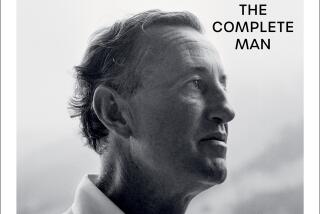Docs explain why James Bond prefers his martinis ‘shaken, not stirred’
- Share via
Scientists know that the best way to make a vodka martini is to mix the ingredients with a thin wooden spoon -- it combines the ingredients effectively without raising the drink’s temperature the way a metal stirrer would. So why would James Bond, the world’s most sophisticated martini drinker, routinely order his cocktail “shaken, not stirred”?
A trio of British medical researchers believe they have the answer: The heavy-drinking 007 most likely suffered from an alcohol-induced tremor that forced him to shake his martinis. In fact, they argue, the British Secret Intelligence Service agent with a license to kill consumed so much alcohol that he ought to be dead.
“Ideally, vodka martinis should be stirred, not shaken,” the researchers report in the British Medical Journal’s Christmas issue. “That Bond would make such an elementary mistake in his preferences seemed incongruous with his otherwise impeccable mastery of culinary etiquette.”
The BMJ’s Christmas issue is known for its wacky medical reports, but the authors who diagnosed James Bond took the matter quite seriously. For starters, they used the books by Sir Ian Fleming as their source material, not the movies. Two of the 14 books were excluded from the analysis -- “The Spy Who Loved Me” was dropped because it was told from the point of view of a waitress who doesn’t introduce Bond until two-thirds of the way into the story, and “Octopussy and the Living Daylights” failed to make the cut because it’s a series of short stories. The other 12 books were read by the study authors, curled up at home in “comfy” chairs.
INFOGRAPHIC: Bond, Jamesss Bond
As they read, the researchers took detailed notes about Bond’s activities, including his drinking. They looked up drink recipes on Wikipedia to figure out the ingredients in each of his cocktails. In cases where the storyline was vague -- i.e., Bond “got drunk” or there was an order to “bring in the drink tray” -- the researchers made “relatively conservative estimates in the context of his overall drinking habits,” according to the study. Then they crunched all their numbers.
The study authors calculate that the total elapsed time in the 12 novels added up to 123.5 days, during which 007 consumed 9,201.2 grams of pure alcohol. (That’s not the combined volume of his many cocktails -- that’s just the amount of 200-proof ethanol.) This works out to 521.6 grams of pure alcohol per week, or 74.5 grams per day.
For the sake of comparison, the British National Health Service advises men not to exceed 168 grams of alcohol per week, with no more than 32 grams on a single day and at least two days per week that are alcohol-free.
Among Bond’s 123.5 recorded days, 48.5 were alcohol-free. But on 36 of those days, he was not alcohol-free by choice: On these occasions, he was locked up in jail, laid up in a hospital or doing a stint in rehab and unable to imbibe. Taking those days out of the equation, the 9,201.2 grams over 87.5 days averages out to 738 grams of pure alcohol per week, or 105.1 grams per day.
But that’s just an average. The peak of 007’s drinking came on Day 3 of the mission described in “From Russia With Love.” During that 24-hour period, 007 drank a whopping 398.4 grams of pure alcohol, the study authors calculated. To consume that much alcohol, you’d have to down about 14 vodka martinis (assuming they’re made with the 100-proof vodka, the strongest option listed on this handy cocktail content calculator from the U.S. National Institute on Alcohol Abuse and Alcoholism, one of the National Institutes of Health). If you’re drinking something more tame, like beer or wine, it would take about 25 glasses to get the same amount of alcohol.
These drinking habits would put Bond at serious risk of some serious diseases, including hypertension, stroke, depression and sexual dysfunction, “which would considerably affect his womanising,” the study notes.
Most important, the study authors say, Bond’s risk of developing liver cirrhosis is at least seven times greater than for a nondrinker. A person with cirrhosis dies at age 59, on average, according to the BMJ study.
Fleming, a heavy drinker and smoker, died of heart disease when he was only 56, and “we suspect that Bond’s life expectancy would be similar,” the researchers write. Bond himself had even lower expectations: In “Moonraker,” he says he expects to be killed before he turns 45 and is forced to retire from the “00” section of MI6.
Perhaps this helps explain why: In “Goldfinger,” Bond drives home after consuming 144 grams of pure alcohol in an evening with Auric Goldfinger. And in “Casino Royale,” 007 has 312 grams of alcohol before participating in a high-speed car chase that lands him in the hospital for two weeks. “We hope that this was a salutatory lesson,” the study authors write.
Getting back to the issue of Bond’s shaken martinis, the researchers cite a 2009 study in the Journal or Neurology, Neurosurgery & Psychiatry that pegged heavy drinkers as having a four times greater risk of developing an essential tremor compared to light drinkers. Essential tremor is an unintentional rhythmic muscle movement of one or more parts of the body, according to the National Institute of Neurological Disorders & Stroke. The most common body part affected is the hand, the institute says.
“James Bond was unlikely to be able to stir his drinks, even if he would have wanted to, because of likely alcohol induced tremor,” the researchers conclude.
Bond’s heavy drinking may have been a response to his job stress as well as his need to rub elbows with folks who aren’t exactly teetotalers, the study authors note: “We appreciate the societal pressures to consume alcohol when working with international terrorists and high-stakes gamblers.”
But that’s no excuse for being such a lush, the researchers add. “We would advise Bond be referred for further assessment of his alcohol intake and reduce his intake to safe levels.”
They are doctors, after all.
If you like the idea of real doctors getting serious about James Bond’s fake drinking, you like the things I write about. Follow me on Twitter and “like” Los Angeles Times Science & Health on Facebook.
ALSO:
Is your designated driver drunk?
Do men and women view drunkenness the same way?
Booze in space: Is methanol reaction ‘cheating’ laws of physics?







